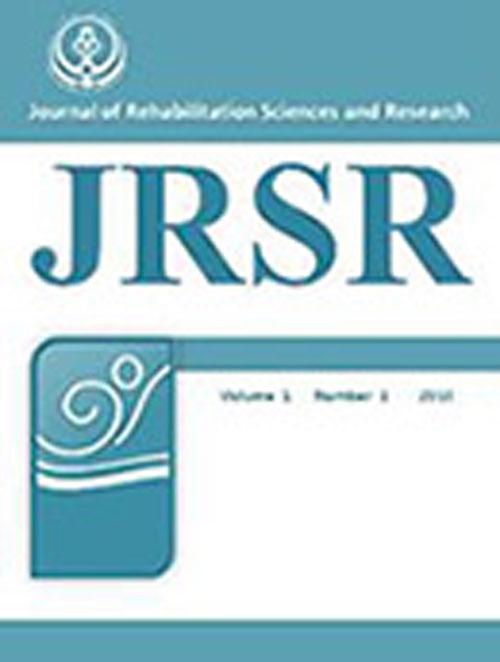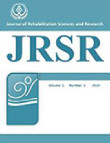فهرست مطالب

Journal of Rehabilitation Sciences and Research
Volume:5 Issue: 1, Mar 2018
- تاریخ انتشار: 1396/11/30
- تعداد عناوین: 5
-
-
Pages 1-4BackgroundThe occurrence of migraine and vertigo is common in the general population. Migraine vertigo is challenging and has several common symptoms with inner ear pathologies like Endolymphatic Hydropse. This paper presents a review of recent findings about symptoms, test results, pathophysiology and differential diagnosis.MethodsThe present study is a review of 35 papers in the field of vestibular migraine. They were selected by searching the keywords vertigo, dizziness, migraine, treatment and rehabilitation in Pubmed, ScienceDirect, Scopus and Google Scholar search engines. Only human studies were included.ResultsRecent findings have proposed several common pathophysiologies between vestibular system and migraine including spreading depression in the basilar artery, vasospasm in the internal auditory artery, involvement of the connection with locus coeruleus, dorsal raphe nucleus, disorder of multisensory integration and channelopathy.ConclusionFor the differential diagnosis of vestibular migraine, it appears that comprehensive case history as well as clinical testing and patient followup, are the best combination. In addition, it has been proven that vestibular rehabilitation is beneficial to patients with vestibular migraine.Keywords: Vestibular System, Migraine, Vertigo
-
Pages 5-12BackgroundWhile various studies have examined motor control differences between subjects with and without low back pain (LBP), only a few have investigated the muscle recruitment pattern in classified LBP patients during functional activity. The aim of this study was to investigate the firing pattern of the main muscles involved in sit-to-stand (STD) and stand-to-sit (STS) tasks in two prevalent LBP subgroups based on movement system impairment (MSI) classification.MethodsA total of 37 women between 18 and 50 years of age voluntarily participated in this cross-sectional study. They were divided into three groups (15 healthy, 15 lumbar extension rotation syndrome (LERS), and seven lumbar flexion rotation syndrome (LFRS)). Surface electromyography was recorded bilaterally from the trunk stabilizer musclesi.e. the internal oblique (IO), lumbar erector spine (ES), and hip mobilizer musclesand the medial (MH) and lateral (LH) hamstring muscles during STD and STS tasks. The variations in EMG onset muscle timing and asymmetry in side-to-side muscle timing were measured.ResultsThe firing sequence during the STD task showed no significant difference among groups. However, in the healthy and LFR groups the trunk stabilizer muscles were activated before the hip mobilizer muscles, and in the LERS group an insignificant delay was shown in the onset of the ES activity. There was no significant difference of bilateral muscle timing during STD. In the STS task no consistent order of pattern was found even in the healthy group. The bilateral muscle timing of IO (mean difference, -427.00; P=0.021) and ES (mean difference, 1964.57; P=0.000) had significant difference in the LFRS group during STS.ConclusionThe cumulative effects of recruitment pattern impairment may contribute to continuing the cycle of lumbar movement impairments and subsequent persistence of LBP.Keywords: Low back pain, Classification, Surface electromyography, Recruitment pattern
-
Pages 13-17BackgroundStuttering is a communication disorder. It is expected that stuttering may have negative impact on individuals mental and emotional health, which may affect their quality of life. Therefore, this paper aims to study components of social phobia inventory in Persian adults with stuttering and compare the likelihood (odds) of social phobia in the stuttering group to that in the control group.MethodsUsing social phobia inventory, this case-control study compared social phobia in 33 adults with stuttering and 33 age-gender-education matched subjects with fluent speech. All the participants were 18 years or above.ResultsIndependent t-test showed that the total score of the social phobia inventory. Its fear component has significant statistical differences between group of adults with and without stuttering. Moreover, the adults with stuttering have over two times more social phobia symptoms than that in ones who dont.ConclusionOur results suggest that social phobia should be considered in therapy programs for adults with stuttering. In addition to restructuring speech, a part of the treatment program should address peoples social phobia, especially their feeling of fear, in order to curtail some of the negative consequences associated with stuttering.Keywords: Stuttering, Social phobia, Fear
-
Pages 18-24BackgroundThe effects of aquatic exercises on strength and balance are still controversial, nevertheless an attempt has been made to investigate the effect of underwater trampoline exercise, in comparison with traditional aquatic exercise, on strength, balance, and quality of life in middle-aged womenMethodsA total of 26 middle-aged women participated in this study. The participants were randomly allocated into two groups, i.e. underwater trampoline exercise (age: 44.8±10.3yr, height: 1.62±0.6 m, weight: 76.2±8.6 kg) and traditional aquatic exercise (age: 45.7±8.8yr, height: 1.58±0.5 m, weight: 71.8±8.8 kg), using a matching method. Static balance (by stork test), strength (by dynamometer), and quality of life (by SF 36 questionnaire) data were collected before and after applying an 8-week exercise regime (three sessions per week, each session of 3045 minutes duration). Finally, the data was analyzed by repeated measures ANOVA using SPSS software (Version 21) (PResultsThe data analysis showed a significant interaction (PConclusionThe current study showed that underwater trampoline exercises can well affect the balance and strength of the users. The underwater trampoline group showed better progress in terms of the mentioned criteria. Therefore, it can be concluded that the underwater trampoline device can create a unique aquatic environment for enhanced therapeutic treatment and musculoskeletal rehabilitationKeywords: Attention deficit, hyperactivity disorder, Compensatory rehabilitation, Neuropsychological functions
-
Pages 25-29BackgroundExecutive functions are impaired in children with attention deficit- hyperactivity disorder. One method to improve these functions is Compensatory rehabilitation. This study aims to assess the effectiveness of compensatory rehabilitation training on neuropsychological functions in preschool children with attention deficit- hyperactivity disorder (ADHD) symptoms.MethodsThis is an experimental study by pretest, posttest and follow-up design with control group. Thirty two (32) children with attention deficithyperactivity disorder symptoms were selected using convenience sampling and randomly divided into control and intervention groups. The neurological tests included missing scan, day and night stroop, continuous performance test and trial making test. In the intervention program, parents were taught how to use effective strategies and skills to manage cognitive deficits in children, based on Tameshk package. Data was analyzed by repeated measure analysis of variance (ANOVA).ResultsFrom the results of data analysis, compensatory rehabilitation had a significant effect on working memory (PConclusionCompensatory rehabilitation utilizes skills and instructions to improve cognitive functions in children. The current research showed that training by compensation approach could improve neuropsychological functions in children with ADHD.Keywords: Underwater trampoline, Aquatic exercise, Strength, Balance, Women


